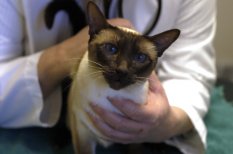

Pets often have minor illnesses or injuries that don't cause any lasting harm. Naturally you don't need to run to the vet every time your pet sneezes, but how do you know when it's time to go see your vet?
It can be hard to tell if your pet is suffering since so many animals hide signs of distress. Warning signs that all is not well with your pet include:
Changes in appetite, such as refusing to eat for a couple of days or showing no interest in food. While it's not uncommon for dogs to skip a meal here and there, but repeated refusal to eat could indicate something more serious. Likewise, if you notice that your pet is eating much more than usual (or stealing food when it's not something they would normally do), then bring it to your vet's attention.
Drinking a lot more water than usual. This could be a sign of diabetes or kidney disease. It's hard to tell how much your pet drinks - especially if you live in a multi-pet household - but you may notice that your pet has to urinate more frequently, or he may start to have accidents in the house.
Changes in body weight or appearance. You might notice that your pet has lost weight even though he continues to eat well... or perhaps he looks a fair bit heavier even though his appetite seems to be the same.
Also pay attention to your pet's coat. His fur should be shiny and healthy-looking. A dull, dry, rough, or patchy coat might indicate allergies or other skin problems.
Lethargy - no interest in walks, toys, games, or anything else that usually interests your pet. Your pet may seem overly tired. Of course, everyone can have an "off" day when they're not feeling 100% - even pets! But if your pet is lethargic for more than a day or two, contact your vet.
Shortness of breath, coughing, excessive panting, or whimpering when touched.
Lumps that "suddenly" appear. It's not always easy detecting lumps under your pet's furry coat, but large lumps, lumps that appear painful, or lumps that seem to be changing or growing should be examined by your vet.
A protruding or bloated abdomen could indicate a serious problem and should be examined by a vet immediately.
Dogs and cats often vomit, but repeated vomiting, or vomiting that is prolonged, strained, bloody, or painful should be brought to your vet's attention.
Excessive drooling could indicate mouth problems or even poison.
Fever is a cause for concern, especially when found combined with another sign of illness.
Difficulty urinating or straining when defecating. And - unpleasant though it may be - check your pet's poop for signs of bloodiness or mucous.
Other more obvious signs of illness in your pet include fainting or collapse, seizures, or paralysis.
If in doubt, it's always best to be cautious. A visit to the vet, even if it turns out to be unnecessary, will at least give you peace of mind that your pet is okay. family - pets included!
To request reprint permission please contact us.
Copyright © 2005-2016 Pet Information All Rights Reserved
Contact us: www162date@outlook.com